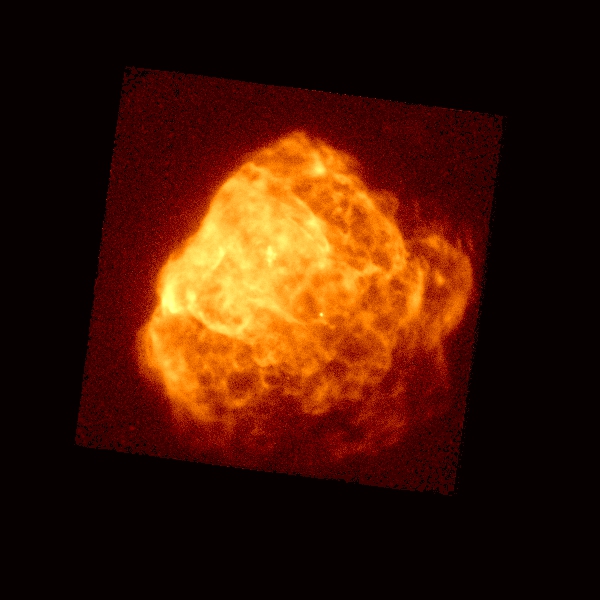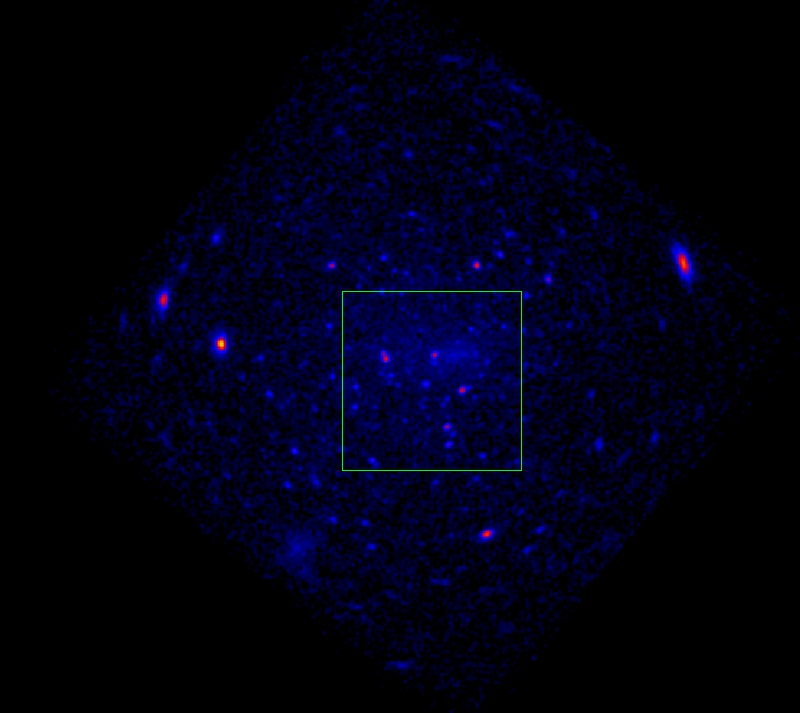Einstein Probe opens its wide eyes to the X-ray sky
- Einstein Probe’s first images illustrate the satellite’s full potential and show that its novel optics, which mimic a lobster’s eyes, are ready to monitor the X-ray sky
- The space X-ray telescope zoomed in on a few well-known celestial objects to give us a hint of what the mission is capable of
- The IEEC and the Institute of Space Sciences are highly involved in the mission through the participation of researcher Nanda Rea in its science management committee and Francesco Coti Zelati and Alessio Marino as affiliated members

Caption: An image of supernova remnant Puppis A in X-ray light, taken as part of the test and calibration campaign of Einstein Probe. Puppis A is the remnant of a supernova explosion that occurred 4000 years ago, the bright dot in the centre is the remnant star. The cloud-like structure surrounding it comes from hot material generated and expelled during the supernova. Einstein Probe’s Follow-up X-ray Telescope (FXT) took this image. Accompanying this image, FXT also delivered a spectrum of the source tracing the energy distribution of its light. This enables scientists to find out which are the elements present in this supernova remnant.
Credits: Chinese Academy of Sciences.
Launched on 9 January 2024, the Chinese Academy of Sciences (CAS) spacecraft Einstein Probe joins ESA’s XMM-Newton and JAXA’s XRISM in their quest to discover the Universe in X-ray light. The mission is a collaboration led by CAS with ESA, the Max Planck Institute for Extraterrestrial Physics (MPE) (Germany), and the National Centre for Space Studies (CNES) (France).
In the months since liftoff, the mission operations team has been performing the necessary tests to confirm the spacecraft’s functionality and calibrating the scientific instruments. During this crucial phase, Einstein Probe captured scientific data from various X-ray sources.
These first-light images demonstrate the outstanding capabilities of Einstein Probe’s two scientific instruments. The Wide-field X-ray Telescope (WXT) can observe a panorama of nearly one-eleventh of the celestial sphere in one shot, while the more sensitive Follow-up X-ray Telescope (FXT) offers close-ups and can pinpoint short-lived events caught by WXT.
“I am delighted to see the first observations from Einstein Probe, which showcase the mission’s ability to study wide expanses of the X-ray sky and quickly discover new celestial sources,” says Prof. Carole Mundell, ESA Director of Science. “These early data give us a tantalising glimpse of the high-energy dynamic Universe that will soon be within reach of our science communities. Congratulations to the science and engineering teams at CAS, MPE, CNES and ESA for their hard work in reaching this important milestone.”
The capability of the mission to promptly spot new X-ray sources and monitor how they change over time is fundamental to improving our grasp of the most energetic processes in the cosmos. Powerful X-rays are blasted through the Universe when neutron stars collide, supernovas explode, and matter is swallowed by black holes or ejected from the crushing magnetic fields that envelop them.
Nanda Rea, Researcher Professor from the Institute of Space Studies of Catalonia (IEEC) at the Institute of Space Sciences (ICE-CSIC), is a member of the ESA Einstein Probe Science Team, Chair of the Science Topical Panel on Compact Objects (studying neutron stars, black holes, white dwarfs, their environments and Galactic populations), as well as part of the Einstein Probe Science Management Committee, which determines the scientific policy of the mission. In addition, IEEC postdoctoral researchers at the ICE-CSIC Dr Francesco Coti Zelati and Dr Alessio Marino are also involved as associated members to the Science Topical Panel on Compact Objects.
“Not only will Einstein-Probe be the perfect ‘hunter’ for new transient X-ray sources but, given its unprecedented large field of view, it will also allow for a systematic characterization of the X-ray properties of sources located in areas of the sky that have never been observed before. The potential for new exciting discoveries is huge,” says Francesco Coti Zelati.

Caption: This panoramic view of our Milky Way in X-ray light was taken as part of the calibration and test campaign of Einstein Probe in space. During this test observation lasting more than 11 hours, the satellite detected various celestial objects that generate X-rays. Each object is captured as a purple cross due to the way the spacecraft’s novel lobster-eye optics work. The X-ray observations are shown on top of an optical image of the Milky Way created by European Southern Observatory ground-based telescopes.
Credits: EPSC, NAO/CAS; DSS; ESO.
Lobster eyes monitoring the Universe
Einstein Probe’s WXT instrument consists of twelve modules featuring the novel lobster-eye technology that was tested in flight in 2022 by the technology demonstrator LEIA (Lobster Eye Imager for Astronomy). The twelve modules provide a field of view of more than 3600 square degrees, allowing Einstein Probe to monitor the whole night sky in just three orbits.
“With its unprecedented “sight”, Einstein Probe’s WXT will catch all sorts of cosmic explosions in the sky while keeping an eye on known astronomical sources checking for any unexpected sign of activity. It is a game changer for modern astronomy,” adds Alessio Marino.
During its first months in space, WXT started its work of keeping a watchful eye on the X-ray sky. Detections of energetic objects look like a lit-up plus sign due to the way the instrument’s novel lobster-eye optics work. The first X-ray transient source – an astronomical object that is not continuously shining but pops up and fades again – was discovered on 19 February. This candidate gamma-ray burst lasted for 100 seconds. Einstein Probe discovered another 14 temporary X-ray sources and also captured X-rays from 127 flaring stars.
During the mission, the wide-field instrument’s findings will guide a range of ground- and space-based telescopes to perform follow-up observations in multiple wavelength bands. X-ray follow-up observations can also be obtained using the satellite’s FXT instrument.
Rapid follow-up observations
Einstein Probe’s FXT instrument has a set of two X-ray telescopes for detailed studies of X-ray-emitting objects and events. During the past months, FXT has proved to be a trustworthy instrument to observe a range of X-ray sources. The first images bring into new focus a supernova remnant, an elliptical galaxy, a globular cluster and a nebula.
Remarkably, FXT already performed a follow-up observation of an X-ray event spotted by WXT on 20 March 2024.
“It is astounding that even though the instruments were not yet fully calibrated, we could already perform a time-critical follow-up observation using the FXT instrument of a fast X-ray transient first spotted by WXT,” explains Dr. Erik Kuulkers, ESA’s Einstein Probe Project Scientist. “It shows what Einstein Probe will be capable of during its survey.”
What’s next?
In the coming months, Einstein Probe will continue to undergo in-orbit calibration activities before starting its routine science observations around mid-June. During the three-year mission, the satellite will circle Earth at a height of 600 km and keep its eyes on the sky searching for transitory X-ray events. Using the FXT follow-up telescope, the mission will look deeper at newly detected events and other known interesting objects.

Caption: Omega Centauri is the largest cluster in the Milky Way, with a mass a million times that of our Sun. During Einstein Probe’s first months in space, observations of the well-known cluster helped to test and calibrate the satellite’s imaging quality. Binary systems comprising a star with a black hole or neutron star companion generate X-rays when material from the star falls onto its heavy companion. Many such systems call Omega Centauri their home, making it shine brightly in X-ray light. Einstein Probe’s Follow-Up X-ray Telescope observed the structure and core region of the globular cluster.
Credits: Chinese Academy of Sciences.
“We are now in a golden moment to unveil the physics governing transient high energy objects in the sky. Having privileged data of the Einstein Probe mission will allow our group to have a strong lead in the huge discoveries that we are expecting in the next few years,” says Nanda Rea.
Einstein Probe’s capabilities are highly complementary to the in-depth studies of individual cosmic sources enabled by XMM-Newton and XRISM. Its survey is fundamental to prepare for X-ray observations by ESA’s future NewAthena mission, currently under study and set to be the largest X-ray observatory ever built.
Press release prepared in collaboration with the Institute of Space Sciences.
Contacts
IEEC Communication Office
Barcelona, Spain
E-mail: comunicacio@ieec.cat
Lead Researcher at the IEEC
Barcelona, Spain
Nanda Rea
Institute of Space Studies of Catalonia (IEEC)
Institute of Space Sciences (ICE-CSIC)
E-mail: rea@ieec.cat
About the IEEC
The Institute of Space Studies of Catalonia (IEEC — Institut d’Estudis Espacials de Catalunya) promotes and coordinates space research and technology development in Catalonia for the benefit of society. IEEC fosters collaborations both locally and worldwide and is an efficient agent of knowledge, innovation and technology transfer. As a result of more than 25 years of high-quality research, done in collaboration with major international organisations, IEEC ranks among the best international research centres, focusing on areas such as: astrophysics, cosmology, planetary science, and Earth Observation. IEEC’s engineering division develops instrumentation for ground- and space-based projects, and has extensive experience in working with private or public organisations from the aerospace and other innovation sectors.
The IEEC is a non-profit public sector foundation that was established in February 1996. It has a Board of Trustees composed of the Generalitat de Catalunya, Universitat de Barcelona (UB), Universitat Autònoma de Barcelona (UAB), Universitat Politècnica de Catalunya · BarcelonaTech (UPC), and the Spanish Research Council (CSIC). The IEEC is also a CERCA centre.
